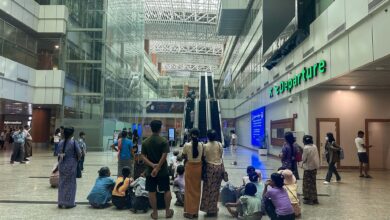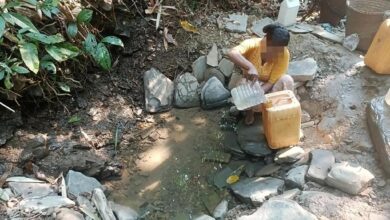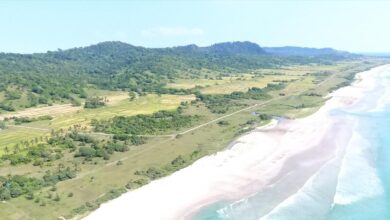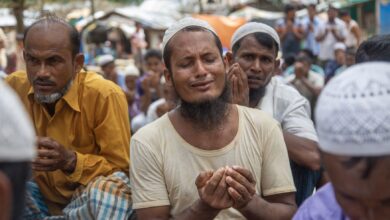
On the morning of March 8, two men from villages in Sagaing Region’s Yinmarbin Township took their elderly relatives to a monastery in Letpan Taw, a village surrounded on three sides by the Yamar River, amid concerns about the approach of junta soldiers.
Htoo Kyaw and Htay both believed that the monastery would be the safest place for their loved ones to stay as the regime forces passed through the area. The military soon proved them wrong.
While the two men and most other able-bodied villagers fled to safety, a column of around 150 junta soldiers bore down on Letpan Taw after torching several other villages along the way. To ensure that their advance was unimpeded, they fired heavy artillery ahead of them.
One shell fell on the monastery. Eleven people sheltering inside were killed instantly. (Myanmar Now reported at the time that six people were found dead according to information received after the incident.)
Eight of the victims were elderly residents too weak to run. The other three were a mother and her two young sons.
“We sent them there because we didn’t imagine they would be cruel enough to fire on a monastery,” said Htoo Kyaw, who lost his grandmother and aunt in the attack.
Htay, whose grandmother and aunt also died, was also in a state of disbelief. “It makes me feel guilty, as if I had a hand in their deaths,” he said.
“Everything has fallen apart. I can barely stand on my own now,” said the husband of the 32-year-old woman who was killed along with their two sons, aged 5 and 11.

‘No time to prepare’
The military column that attacked Letpan Taw arrived in the area two days earlier. Before that, in late February, it had raided two other villages in the township, Chin Pone and Thapyay Aye, setting fire to the homes of fleeing residents.
When the troops reached Thakyar Sat and Si Hlaing, two villages on the banks of the Yamar River, on March 6, they immediately set about doing the same. As they moved closer to Letpan Taw, they continued to burn down more houses, including some that had villagers hiding in them.
Residents of Letpan Taw thought at first that they would be spared because of their village’s relative isolation. The only way to reach it is across the river from Aung Chan Thar, another village on the opposite shore.
“The village is almost completely surrounded by the river, so people didn’t think the military would actually go there. But they did, and no one had time to prepare,” said a Letpan Taw villager who did not want to be identified.
“They fired on us with machine guns. It was as if it was raining bullets. They also used heavy artillery. Everyone just scattered like ants,” he added.
To escape, those still in Letpan Taw—who included residents of villages that had already come under attack—crossed the river to Kanthar and kept running until they reached the villages of Ohn Taw and Shwe Nyaung Bin.
According to another local, one shell landed on the dining hall of the village monastery, doing extensive damage to its roof and door. A number of bodies were also seen on lying the ground, he said.
“We couldn’t see the extent of their injuries, as they were face down. But some had been hit by shrapnel in the back of the neck,” he said.
Charred remains
The assault on Letpan Taw was over by 11am. Worried about his grandmother and aunt, Htoo Kyaw returned to the village with three others almost as soon as the gunfire stopped.
They returned too soon, however. While they were looking for casualties, they encountered some soldiers who immediately arrested them and tied their hands behind their backs.

It was while they were being marched through the monastery compound that Htoo Kyaw saw the bodies of those who had been killed laid out in a row.
“They were lined up on the ground. I could easily identify my grandmother as one of them,” he said.
Htoo Kyaw and the others were then blindfolded. They remained that way until the evening, by which time the bodies had disappeared.
Next to the monastery, a house was on fire. Htoo Kyaw said he believed that was where the bodies had gone.
For the next three days, he and the other three locals were forced to act as porters for the soldiers as they continued through the villages of Kanthar, Thee Kone, and Obo. They were released unharmed on March 11.
In the meantime, other villagers returned to Letpan Taw on the morning of March 9 to find the charred remains of 10 people in two houses.
Only the body of one woman had not been reduced to ashes.
Five days later, a ceremony was held for the victims of the attack. Because the monks from Letpan Taw’s monastery had also been forced to flee, others from a nearby village were invited to bless the deceased.

Worse to come
“We are very afraid of these raids, but we’ve been told it’s only going to get worse, so we don’t know what to do or where to run anymore,” said Htoo Kyaw.
What makes the situation especially alarming for many, he added, is the fact that they now know that even monasteries are not safe.
“We used to think of monasteries as refuges, but now soldiers are even using them as base camps. That means the only way we can protect our elderly is by sending them somewhere far away, like Mandalay,” he said.
A leader of Kanthar’s village defence force said that it is also becoming increasingly difficult to protect civilians by fighting back against the regime’s forces.
“We engaged them while they were stationed at the monasteries in Letpan Taw and Kanthar, but we could not force them out because they had more men and superior firepower,” he said.
Since earlier this month, the regime has stepped up its attacks in Sagaing, where it also cut off internet access on March 3 as part of a campaign to crush resistance to its rule.
Although resistance forces in the region say they can still mount effective attacks using explosives, they also acknowledge that it will take a more concerted effort to keep up the pressure on the regime.
To this end, the defence department of the shadow National Unity Government has told Myanmar Now that it is in the process of integrating defence forces scattered all over the country, in a bid to bolster their strength.
Meanwhile, popular support for the armed resistance movement appears to be as strong as ever, despite the high number of civilian casualties.
A farmer from Letpan Taw said the junta’s deliberate targeting of helpless civilians has only served to make the country’s would-be rulers more hated.
“The people of Myanmar are now more determined than ever to prevent the military from holding onto power or ever coming to power again,” he said.



